
MICROSCOPY AND MICROANALYSIS
Scope & Guideline
Unveiling the Microscopic World
Introduction
Aims and Scopes
- Advanced Microscopy Techniques:
The journal features research on cutting-edge microscopy techniques such as electron microscopy, scanning probe microscopy, and atomic probe tomography, showcasing innovations that enhance imaging resolution and analytical capabilities. - Interdisciplinary Applications:
Publications often bridge multiple disciplines, including materials science, biology, and environmental science, demonstrating the diverse applications of microscopy in analyzing complex samples and systems. - Quantitative and Analytical Methods:
There is a strong focus on quantitative analysis and the development of novel analytical methods, including machine learning approaches, for extracting meaningful data from microscopic images. - Ultrastructural Studies:
The journal emphasizes studies that delve into the ultrastructural characteristics of biological tissues, materials, and nanostructures, providing insights into their functionality and properties. - Innovative Sample Preparation Techniques:
Research often includes advancements in sample preparation methodologies that enhance the quality and precision of microscopic analysis, crucial for obtaining reliable results.
Trending and Emerging
- Machine Learning in Microscopy:
An increasing number of studies are incorporating machine learning algorithms for image analysis and classification, showcasing the potential of AI to enhance the accuracy and efficiency of microscopic investigations. - Cryo-Electron Microscopy:
Cryogenic techniques are gaining momentum, with a focus on cryo-electron microscopy applications in biology and materials science, allowing for the visualization of samples in near-native states. - Atom Probe Tomography Advancements:
Research on atom probe tomography is on the rise, particularly studies focused on improving analytical precision and expanding its applications in materials characterization. - 4D-STEM and Dynamic Imaging:
The trend towards four-dimensional scanning transmission electron microscopy (4D-STEM) is evident, as researchers explore dynamic processes at the nanoscale, providing insights into material behavior under various conditions. - Correlative Microscopy Techniques:
There is a growing interest in correlative microscopy, which combines multiple imaging techniques to provide a more comprehensive understanding of sample structures and properties, bridging gaps between different scales of analysis.
Declining or Waning
- Traditional Histology Techniques:
Papers focusing solely on conventional histological techniques without integration with advanced imaging methods have decreased, as researchers seek more innovative and quantitative approaches. - Basic Microscopy Techniques:
There is a noticeable decline in publications centered around basic microscopy techniques, such as standard light microscopy, as the field increasingly gravitates towards more sophisticated and high-resolution methods. - Non-Quantitative Studies:
Research that lacks a quantitative aspect or fails to incorporate advanced analytical techniques is becoming less common, as the emphasis shifts towards data-driven and reproducible results. - Generalized Material Studies:
There has been a reduction in publications that broadly discuss material properties without specific applications or advanced characterization techniques, as niche and application-focused studies gain traction.
Similar Journals
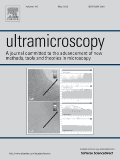
ULTRAMICROSCOPY
Illuminating Innovations in Optical and Magnetic MaterialsULTRAMICROSCOPY is a premier journal published by Elsevier, specializing in the fields of atomic and molecular physics, optics, as well as electronic, optical, and magnetic materials. Established in 1975 and continuing its publication through 2024, this journal has earned a distinguished reputation, reflected in its classification within Q1 and Q2 quartiles, representing the top 25% of journals in its category. With a Scopus rank of 49 out of 141 in the instrumentation domain, it holds a compelling percentile rank of 65%, demonstrating its impact and relevance in advancing research. The journal serves as an essential platform for researchers, professionals, and students alike, promoting high-quality, peer-reviewed articles that explore innovative techniques and applications in microscopy. While ULTRAMICROSCOPY is not open access, it continues to play a crucial role in disseminating cutting-edge findings to the scientific community globally, fostering collaboration and discussion among experts in the field.

Inorganic Materials-Applied Research
Advancing the Frontiers of Inorganic InnovationInorganic Materials-Applied Research is a pivotal journal dedicated to the dissemination of innovative research in the field of inorganic materials. Published by SpringerNature, this journal operates as a vital resource for researchers, professionals, and students alike, providing a platform for cutting-edge findings and methodologies related to the synthesis, characterization, and application of inorganic materials. With an ISSN of 2075-1133 and an E-ISSN of 2075-115X, the journal strives to bridge gaps in interdisciplinary studies, fostering collaboration across the engineering and materials science domains. Despite its current rankings placing it in the Q3 quartile for both Engineering and Materials Science categories, the journal aims for broader impact, seeking to enhance its visibility and contribution in publications through rigorous peer-review and open access options. Converged from 2010 to 2024, it remains committed to advancing knowledge and addressing contemporary challenges in materials science, thereby attracting contributions that are not only academically rigorous but also socially impactful.

Physics and Chemistry of Solid State
Connecting Researchers to Shape the Future of Solid-State StudiesPhysics and Chemistry of Solid State is a distinguished open access journal published by Vasyl Stefanyk Precarpathian National University in Ukraine, dedicated to advancing research in the fields of condensed matter physics, materials science, and physical and theoretical chemistry. Since its inception in 2000, the journal has provided a platform for the dissemination of innovative ideas and original research findings, contributing significantly to the global scientific community. With a variety of access options, it facilitates the sharing of knowledge and collaboration among researchers worldwide. The journal has garnered recognition with respectable rankings in Scopus, positioning itself among the significant publications in its domain, particularly noted for its contributions to materials science and condensed matter physics. As it moves through its converged years from 2018 to 2024, Physics and Chemistry of Solid State aims to foster interdisciplinary dialogue and prepare the next generation of scientists to tackle complex challenges in solid-state research.
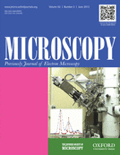
Microscopy
Fostering Collaboration in the World of MicroscopyMicroscopy, published by Oxford University Press, is a prestigious journal dedicated to advancing the field of microscopy and imaging in biological and applied sciences. With a dynamic coverage dating from 1953 to the present, it offers vital insights into the latest techniques and applications across various disciplines, including Instrumentation, Radiology, Nuclear Medicine and Imaging, and Structural Biology. The journal is recognized for its quality, illustrated by its Q2 and Q3 quartile rankings in relevant categories for 2023. Researchers, professionals, and students will find Microscopy an invaluable resource for keeping abreast of contemporary developments and methodologies in the field. As an open-access journal, it promotes equitable access to cutting-edge research and fosters collaboration among the international scientific community, making it essential reading for anyone involved in microscopy research and its applications. For more information, please visit their site for access options and contributions.
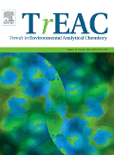
Trends in Environmental Analytical Chemistry
Navigating the Future of Environmental ChemistryTrends in Environmental Analytical Chemistry, published by Elsevier, serves as a leading platform for scholars and professionals in the fields of analytical and environmental chemistry. With an impact factor that places it in the Q1 category for both analytical chemistry and environmental chemistry, this journal attracts cutting-edge research that addresses current challenges in environmental analysis from 2014 to 2024. The journal is dedicated to advancing the knowledge base through the publication of high-quality empirical studies, innovative methodologies, and comprehensive reviews that reflect the latest trends and technological advances in the field. Operating out of the Netherlands, the journal's commitment to excellence is evident in its impressive Scopus rankings, standing as the #1 journal in Analytical Chemistry and #7 in Environmental Chemistry by percentiles. This makes it an essential resource for academics, practitioners, and students alike who are eager to stay informed on impactful environmental research and analytical techniques.
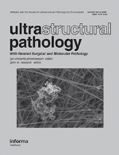
ULTRASTRUCTURAL PATHOLOGY
Exploring the Depths of Structural Biology and PathologyULTRASTRUCTURAL PATHOLOGY is a prestigious academic journal published by Taylor & Francis Inc, focusing on the intricate and detailed aspects of pathology as well as forensic medicine since its inception in 1980. With an ISSN of 0191-3123 and an E-ISSN of 1521-0758, this journal provides a vital platform for researchers and professionals to disseminate innovative findings pertinent to both clinical and experimental pathology. Despite not being an open-access journal, its contributions are critical within its categories, positioned at the Q3 quartile in Pathology and Forensic Medicine and Q4 in Structural Biology as of 2023. The journal's reputation is further underscored by its Scopus rankings, placing it in the 41st percentile for Pathology and 15th percentile for Structural Biology, indicating a competitive standing in these fields. ULTRASTRUCTURAL PATHOLOGY aims to foster rigorous scholarly discourse and advance knowledge through the publication of original research articles, reviews, and case studies, making it an essential resource for academics, practitioners, and students engaged in the evolving domains of pathology and structural biology.

JOURNAL OF ELECTROCERAMICS
Fostering Interdisciplinary Insights in Electroceramic ResearchJOURNAL OF ELECTROCERAMICS, published by SPRINGER in the Netherlands, serves as a pivotal platform for advancing the field of electroceramics since its inception in 1997. With a keen focus on innovative materials and applications, this journal covers diverse areas encompassing ceramics and composites, condensed matter physics, and electronic materials, significantly contributing to interdisciplinary research. Although currently not an Open Access publication, the journal's engagement in rigorous peer review ensures the dissemination of high-quality research, supported by its respectable Q3 ranking in several relevant categories in 2023. Researchers and professionals will find value in its comprehensive scope, showcasing cutting-edge developments that shape the future of engineering and materials science. The JOURNAL OF ELECTROCERAMICS continues to play a crucial role in bridging theoretical discoveries with practical applications, making it an indispensable resource for students, scholars, and industry experts alike.
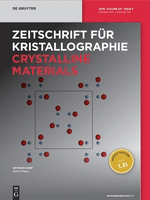
Zeitschrift fur Kristallographie-Crystalline Materials
Transforming Ideas into Crystalline RealityZeitschrift für Kristallographie-Crystalline Materials is a prestigious academic journal published by Walter de Gruyter GmbH, focusing on the intricate field of crystallography and its applications within condensed matter physics, inorganic chemistry, and materials science. Established in Germany, this journal spans a rich history from its inception in 1930 to its convergence years from 2012 to 2024, presenting cutting-edge research and developments in crystalline materials. With an impact factor reflective of its critical role within its field—ranking Q3 in the prestigious quartiles for 2023 across multiple categories—this journal serves as an essential platform for researchers, professionals, and students seeking to expand their knowledge and contribute to the advancement of crystalline materials. While currently not offering open access, the journal remains committed to disseminating high-quality, peer-reviewed articles that inspire innovation and collaboration within the scientific community.

ATOMIC SPECTROSCOPY
Catalyzing Breakthroughs in Analytical Chemistry.ATOMIC SPECTROSCOPY is a distinguished journal specializing in the field of spectroscopy and published by ATOMIC SPECTROSCOPY PRESS LTD. With ISSN 0195-5373 and e-ISSN 2708-521X, this journal has been a cornerstone in advancing the discipline since its inception, thriving in its relevant domain for over four decades, covering converged research years from 1980 to 1989 and from 1996 to 2024. Currently holding a Category Quartile of Q2 in Spectroscopy for 2023, ATOMIC SPECTROSCOPY ranks 34th among 76 in its field according to Scopus, placing it in the 55th percentile, thereby affirming its critical role as a resource for researchers, professionals, and students alike. This journal serves as a platform for disseminating innovative research, methodological advancements, and breakthroughs in atomic and molecular spectroscopy, fostering a comprehensive understanding that is essential for progress in analytical chemistry and related disciplines. While it operates under a non-open access model, the journal ensures broad reach and visibility within the academic community. For those passionate about spectroscopy, ATOMIC SPECTROSCOPY remains an invaluable resource for staying updated on the latest developments, contributing to its reputation as a leading journal in the field.
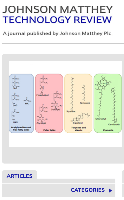
Johnson Matthey Technology Review
Fostering innovation and knowledge exchange in chemical engineering.Johnson Matthey Technology Review is a premier open access journal published by Johnson Matthey Publishing Ltd, dedicated to advancing research and innovation in the fields of Electrochemistry, Metals and Alloys, and Process Chemistry and Technology. Since its transition to open access in 2014, the journal has provided a platform for scholars and industry professionals to share their findings and insights in a rapidly evolving field. Based in the United Kingdom, this journal has garnered significant attention, achieving impressive rankings such as Q3 in Electrochemistry and Q2 in Metals and Alloys, reflecting its growing impact within the scientific community. With a commitment to promoting high-quality, peer-reviewed research, the Johnson Matthey Technology Review plays a vital role in connecting researchers, facilitating knowledge exchange, and fostering collaboration across disciplines, making it an essential resource for anyone involved in material science and chemical engineering.